
Case Study: Sustainable cocoa production in Côte d'Ivoire
Cocoa seeds were first brought into Côte d'Ivoire from neighbouring Ghana. Cultivation gradually spread westwards right across the country to the border with Liberia. By far the leading producer, in 1998 the Côte d'Ivoire produced 41% (1.1 million tonnes) of the world's cocoa beans. Most of these are grown on small farms on cleared land that was once extensive rainforest in the south of the country. There are an estimated 1 - 2 million cocoa farmers, many of whom have migrated to the Côte d'Ivoire from Mali and Burkina Faso.
Pressure on the land
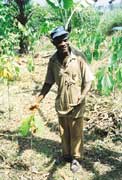
Côte d'Ivoire cocoa farmer with new seedlings
(Click for a larger image)
|
Côte d'Ivoire has one of the fastest deforestation rates in the world, but very little land was originally cleared just to grow cocoa. Cocoa is typically grown on land which has been cleared for timber by logging activities. Today most of the valuable timber has been cut down. Cocoa is an attractive and valuable cash crop for smallholder farmers. Traditionally it was grown fairly intensively for several years in one area before farmers moved on to newly opened up land to start again. Now there are no new areas to open up the pressure is on to find land to grow more. This can result in illegal cultivation in National Parks.
The lack of new land to grow cocoa plus poor yields, diseased crops, insect pests, ageing cocoa trees, and increasing pressure to establish sustainable forms of agriculture has led to the development of a major research project in Côte d'Ivoire.
The PROSTAB project
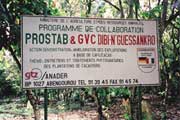
PROSTAB Project, Cote d'Ivoire
(Click for a larger image)
|
The PROSTAB project (Projet de Stabilisation des Systemes de Production Agricole dans la region est de la Côte d'Ivoire) was set up in 1993. It is a collaboration between GTZ (Deutsche Gesellschaft fur Technische Zusammerbeit) and ANADER (Côte d'Ivoire agricultural development). GTZ is one of the world's largest development co-operation consultancy organisations, financed mainly by the German government and employing 10,000 people in 142 countries. They have a 20 year history of working in the Côte d'Ivoire on agriculture, energy, education, infrastructure and veterinary services.
PROSTAB initially set out to improve farming practices and livelihoods in the Abengourou area in the east of the country. It looked to:
- develop the edges of the forest and lowland areas, rather than the forests themselves
- promote the use of leguminous trees e.g. gliricidia, fleminga, to improve soil fertility, reduce fallow periods, and reduce weeding inputs.
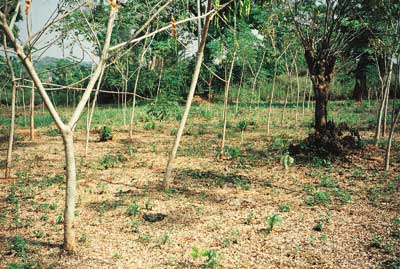
Legume trees protecting young cocoa trees
(Click for a larger image)
|
PROSTAB have made special use of legume trees in cocoa and coffee cultivation. When a piece of land is farmd extensively, with no other inputs, it eventually loses fertility. In the past this land has been abandoned and farming has moved elsewhere. PROSTAB have developed ways to get fallow, degraded land back into production, reducing the need to find new land. Legume trees fix nitrogen in their roots and act like a kind of natural fertiliser. They also provide shade for cocoa, and the wood can eventually be used as firewood for cooking. Other crops e.g. cassava, banana, can be harvested whilst waiting for the cocoa to grow.
PROSTAB have set up nurseries for the production of leguminous trees for sale to farmers. An important PROSTAB (and GTZ) concept is not to give things away for free. To get farmers to take up an idea or piece of technology they must be convinced that it will work, and even be prepared to buy into it. The benefits of intercropping and growing cocoa under the forest canopy are clear, with both farmers and the cocoa crop benefiting from diversification.
Target groups for PROSTAB are local entrepreneurs, rural women, young rural farmers, unions and farmers co-operatives. In cocoa growing areas, PROSTAB are involved in:
- intensifying and diversifying cocoa production
- replanting
- agroforestry techniques and legumes to improve fallow
- legumes and their interaction with cocoa and annual crops
- lowland irrigation and fishing
- livestock improvement
The PROSTAB project has trial and demonstration plots at roadside locations in most cocoa villages in the region. They also have programmes to help farmers manage finances better, and to extend financial management systems down to individual households, especially women.
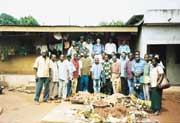
Cocoa quality training programme group
(Click for a larger image)
|
The chocolate industry
A leading chocolate manufacturing company is running a joint project with PROSTAB providing training to show farmers how to produce cocoa of the flavour and quality the company needs. By making a few changes in basic practices, farmers who meet these targets (they can measure it for themselves) receive more money, providing an incentive for them to produce cocoa in what is a more sustainable way. This is a significant change to the way it normally buys cocoa, and is an example of how companies are actively encouraging the movement towards sustainability.
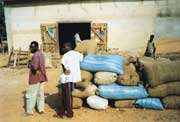
Farmers' co-operative sells premium beans direct
(Click for a larger image)
|
As well as providing training and buying directly from the PROSTAB co-operatives, the company is helping PROSTAB to publicise its work to try and get its methods adopted elsewhere in the country, especially in the west around the Tai forest. The Tai forest is the largest remaining piece of the vast Guinea rainforest which once stretched right across West Africa. It is under intense pressure from illegal farming in what is the country's most important cocoa growing region. By encouraging sustainable cocoa growing outside the Tai forest it is hoped that it will reduce the need to open up new land, thereby reducing the pressure on the Tai forest itself. A similar project is underway between Conservation International and the company around the Marohoué National Park west of Yamoussoukro.
The Future
In the next few years what is learnt from research in areas like Cameroon and groups like PROSTAB in Côte d'Ivoire on cocoa agroforestry, domestication of companion trees, intercropping, farm diversification, breeding for resistance, and biological control of disease, may help other cocoa producing countries in West Africa. Cocoa can then realise its potential as a truly sustainable tropical forest crop with advantages for the farmer, the environment, the chocolate producer and the consumer.
